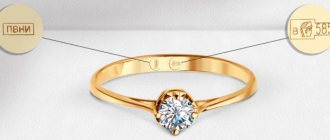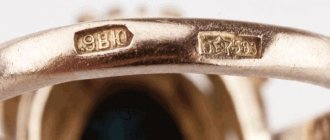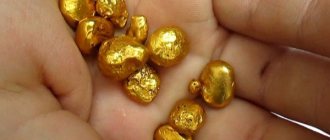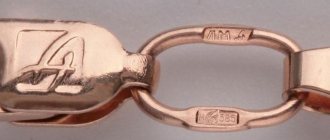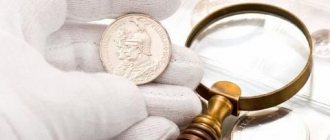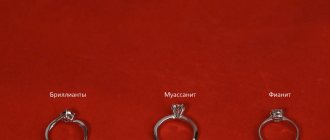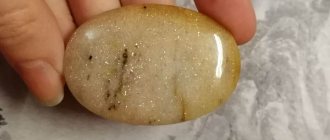Post updated: Oct 9, 2020
Very rarely gold is used in its pure form. Usually the product we call gold consists of the precious metal itself and the so-called alloy, that is, an admixture of other metals. Additives are included in the composition of gold to improve endurance and density, because gold in its pure form is very soft. Pure metal wears out quickly, and products made from it are very easy to scratch or break. High-quality products have a mark on the gold, which we will discuss later.
Even in ancient times, it was calculated that the best impurities for gold were silver and copper. Well, samples began to be used to indicate the gold content in the alloy.
Sample is the main indicator of impurities in a product, but stamps also serve this purpose - marks that are placed in control institutions and guarantee the presence of precious metal in the alloy.
In France, the first hallmark was placed in 1275, but in Russia, the first hallmark appeared on a product in Moscow in 1651-1652. It looked like a double-headed eagle with a date written in Slavic letters, and its purpose was to demonstrate the silver standard. Assays in the modern sense were introduced by Peter the Great in his decree of February 13, 1700, which established 4 assays each for gold and silver.
What is a stamp
Special state marks, which are confirmed by the sample of the gold alloy in the jewelry, are called hallmarks.
All jewelry made from precious metals must be tested and branded before it goes on display in a store and then to the end consumer. By this sign, the buyer understands what metal the jewelry is made of, what grade it is, by whom, when and where it was made.
In almost all countries, branding is a mandatory procedure. In Russia, this is done by the State Assay Chamber. The process is controlled by the Federal Assay Supervision. The imprint is applied according to a single government-approved sample after the product has been tested for compliance with the sample.
We can say that the state mark is a guarantee of the quality of the alloy. The jewelry has been checked by specialists and does contain the specified percentage of gold.
Expert opinion
Vsevolod Kozlovsky
6 years in jewelry making. Knows everything about samples and can identify a fake in 12 seconds
The first stamps on gold items appeared in the 13th century in France. In our country, assaying of gold and silver items was introduced by Peter the Great in the 18th century.
Where is it located and what does it look like
According to the rules adopted in jewelry production, branding should not spoil the appearance of the jewelry. The state sample confirmation mark is placed according to the following rules:
- In an inconspicuous place - on the back of rings, clasps, carabiners;
- Several parts of one product are tested separately;
- On interior items and products of artistic value, an additional plate of the same alloy is attached for stamping.
Rings have a hallmark mark on the back or under the mounts for precious stones, chains and bracelets - on clasps or nearby links, pendants - on holders.
The appearance of the Russian mark has changed several times. In Soviet times, a five-pointed star with a hammer and sickle was applied. The modern brand is the profile of a woman wearing a kokoshnik. Each country develops its own designs for hallmarking alloys of various precious metals.
What is a name tag and how is it different from a brand?
If the mark is a sign of the state certificate of the alloy sample, then the nameplate is the manufacturer’s imprint. It contains the following information:
- individual manufacturer code;
- year of manufacture of the product;
- inspection code of the State Assay Service to which the production belongs (factory or private jeweler).
All this information is encrypted in letters. A Russian-made gold product must have both a name tag and a stamp. The manufacturer's mark has the shape of a rectangle. Next to it is the state stamp.
Specifics of the name
Name tag is a mark that contains information about the manufacturer . The data is encrypted with 4 Russian letters:
- The first letter is the year of manufacture (A - 2001, B - 2002, etc.). The letters Е, Ж, И are not used when applying markings.
- The second is the inspection body.
- The third and fourth are the manufacturer's code.
- If there is a P next to the letters, the product has been restored.
The outline of the nameplate should not contain any other designations - for example, copyright protection or the manufacturer's trademark.
The hallmark stamp on the ring is usually placed to the right of the name mark. All names of manufacturers must be registered with the territorial assay supervision authorities. The contour is determined independently by the territorial assay office. Its form must be the same for all enterprises that operate in the territory of the GIPN and are subject to control by it. For the spark method of imprinting, the characteristic features will be vertical lines between the outline and the letters, as well as a horizontal line in the upper front part.
Methods of stamping gold
The branding method depends on the size and complexity of the finished product. There are three ways to apply markings:
- Mechanical. The oldest and most frequently used (up to 80%) method. The product is fixed and an impression is made using a hammer blow. Mechanical branding is simple and convenient, but on small items there is a risk of deformation.
- Electrospark. Used since the 70s of the XX century. The mark on the ring and other jewelry is burned out with an electric spark. Well suited for branding fragile, hollow products. The application surface must be perfectly smooth, without defects, pores, or roughness. The print is clear and wear-resistant.
- Laser. A complex, materially expensive method. The marking is applied using a laser machine. The print is small, unnoticeable, but clear and easy to read. The method is suitable for any surface - concave, flat, convex. The only requirement is that it must be polished. Laser stamps are more susceptible to wear and tear than others.
Types of stamps
The shape of the imprint depends on the type of precious metal. On gold jewelry the mark has the shape of a spatula, on silver jewelry it is an oval cut off on the sides, and on platinum jewelry it is an elongated octagon. The print looks different in each country. Let me remind you that all products sold in the Russian Federation are subject to hallmarking at the local Assay Office. This means that I will talk about the types of Russian stamps.
Currently, the print depicts the profile of a girl in a kokoshnik. A similar design was on the stamps of the Russian Empire at the end of the 19th and beginning of the 20th centuries. Until 1896, the design looked like a “tee” in the form of the intersection of the hallmark numbers, year of manufacture, coat of arms, and letters. Soviet stamps depicted the head of a worker with a hammer (since 1927), a five-pointed star with a hammer and sickle (since 1958).
Testing systems
The most popular are metric and carat. I will talk about them and other existing sample measurement systems below. Their correspondence table looks like this:
| Metric | Carat | Zolotnikovaya | Lotovaya |
| 375 | 9 | 36 | 6 |
| 500 | 12 | 48 | 8 |
| 583, 585 | 14 | 56 | 9 |
| 750 | 18 | 72 | 12 |
| 1000 | 24 | 96 | 16 |
Carat
Used in the USA and European countries. The karat designation shows how many parts of pure gold are in 24 parts of the alloy. To convert a metric value to a carat value, you need to multiply it by 0.024.
Metric
The most popular system. Used in most countries of the world, including Russia since 1927. Shows how much gold is contained in 1000 units of the alloy.
Zolotnikovaya
Branding using the spool system was used in the Russian Empire, then in the Soviet Union until 1927. It is not currently used. The measurement was based on a pound consisting of 96 spools. Accordingly, the spool test shows how many units of gold contain 96 units of the alloy.
Lotovaya
This testing system is also from the past. It was used in the Middle Ages by Western European peoples - Celts, Germans, Scandinavians. Previously, the mass of the precious metal was calculated in marks, consisting of 16 lots. This test shows how many lots of gold are in one brand of alloy.
Convert carats to grams
The karat measurement of metals should not be confused with the designation of precious stones. There the values change, for example, 513 carats corresponds to a stone weighing 102.6 grams, 583 carats - 116.6 grams, 686 carats - 137.2 grams.
The metric system determines the value of an alloy based on the gold content of 1 kg of the alloy. The most popular standard is 585, which means that per 1000 grams of alloy there are 585 grams of gold and 415 grams of impurities and other metals.
Since different countries have different systems, sometimes buyers get confused in determining the value of a product when choosing jewelry abroad. Gold hallmarks indicated in carats can be easily translated into understandable Russian numbers: 9 carats means a hallmark of 375 gold, 14 carats means 585, and 24 carats corresponds to the purest gold of 999 purity. For the manufacture of rings, 565 and 575 samples are most often used.
Stamps designate not only products made of gold, but also those made of silver and gilded. For example, a pure silver bar is 999 fine, but this composition is not suitable for making jewelry due to its softness and other physical properties. Household items correspond to hallmark 875, and jewelry - to 925. But gold rings, earrings and chains are not marked with hallmarks 593 and 725. Most likely, you got a fake, and you can determine this fact by contacting a pawnshop or buyers. They will evaluate the product.
Most popular samples
Most jewelry is marked with the following hallmarks: 375, 500, 585, 750. 375 gold is considered low-grade. This product usually has a yellow or reddish tint and fades over time.
The middle group (500 and 585 samples) is the most popular. This ratio of precious metal and alloy in the alloy makes the item durable and durable without losing its external shine.
Jewelry of 750 standard is considered high quality. The alloy has a bright yellow color. Even in white gold, the golden yellow is clearly visible. The 750 alloy alloy usually contains other precious impurities - silver, palladium, platinum.
958 gold is rare. Such jewelry is soft and easy to deform. For minting coins, 900 standard is usually used.
What products are being sampled?
According to accepted state standards, all jewelry made of precious metals is subject to testing, regardless of the use of artistic processing or stone inserts. The mark is also placed on anniversary medals or badges, except for state awards.
The sample differs not only in the combination of numbers, but also in its shape. So, for silver jewelry it is an oval, with cuts on both sides; for platinum jewelry - an octagon stretched horizontally; for gold – two combined rectangles, called a “spatula”.
Where do fakes come from and how to distinguish them from the original
Fake marks are applied to jewelry for the purpose of profit. Thus, inferior products are sold at a higher price. Such fraud is punishable by criminal liability.
The biggest risk of buying a fake is purchasing gold second-hand. I advise you not to chase cheapness, but to buy jewelry in large retail chains.
What other fakes are there? Under the guise of gold, unscrupulous sellers can sell jewelry with the inscription, for example, 14K and Goldmult, Gold plated, Goldfeld. This means the base metal is plated with 14k gold.
Forewarned is forearmed. Is even a basic understanding of what a mark on a gold item looks like? to reduce the risk of buying a counterfeit to a minimum. Ask the seller for a magnifying glass or take a magnifying glass with you. Feel free to carefully examine the imprint on the jewelry.
I advise you to refuse the purchase if the stamp is deformed, has uneven borders, or “dancing” numbers. Probably, such a mark has nothing to do with state assay control, but is intended only to disguise a fake or low standard of the alloy.

